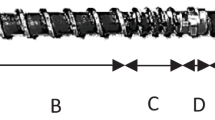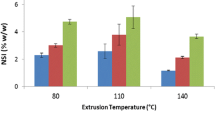Abstract
Production of extrudates from cereals is an often-used technological process in today’s world food industry. Extrudates from corn flour produced using the twin-screw extrusion process and enriched with whey protein concentrate represent high-quality source of proteins and fats. Whey protein concentrate (WPC) as a valuable source of proteins and minerals is one of the highest-quality components for possible extrudate enrichment. In this paper, the influence of various WPC addition and some extrusion process parameters such as feed moisture content (\( Q_{{{\text{H}}_{\text{2}} {\text{O}}}} \)) on physicochemical properties of directly expanded corn flour extrudates manufactured in twin-screw co-rotating extruder was investigated. Whey protein concentrate was added in the following ratios 7.5%, 15% and 22.5% and water in 10.08, 12.18 and 14.28 L/h. Final composition of products is determined with measuring of protein, fat and water shares, water absorption index (WAI) and water solubility index (WSI). With added WPC and with increase of water volume flow, there was a significant rise in total protein, fat and water content in final products, as well as lowering of WSI and rising of WAI indexes. The statistical analysis of the obtained data shows that the lowest WSI and the highest WAI had samples with the largest share of WPC (22.5%) and water volume flow of 14.28 L/h. Colour is measured for each sample, and results were represented with hue angle (H), chroma (C) and lightness (L) values. Process parameters, WPC and \( Q_{{{\text{H}}_{\text{2}} {\text{O}}}} \) influence the increase of saturation of C and lightness of L colour value, while H value stays unchanged. Mean value of H was 90.14 ± 1.06, which corresponds to dominance of yellow colour of samples.







Similar content being viewed by others
Abbreviations
- \( Q_{{{\text{H}}_{\text{2}} {\text{O}}}} \) :
-
Input feed moisture content
- WAI:
-
Water absorption index
- WSI:
-
Water solubility index
- H :
-
Hue angle
- C :
-
Chroma value
- L :
-
Colour lightness value
- a 2 :
-
Blue–green/red–purple colour component
- b 2 :
-
Yellow/blue colour component
- W (P):
-
Protein content
- W (F):
-
Fat content
- W (M):
-
Moisture content
- s 2 :
-
Variance
- R 2 :
-
Correlation coefficient
- \( R_{\text{adj}}^{\text{2}} \) :
-
Adjusted correlation coefficient
References
Akdogan, H. (1999). High moisture food extrusion. International Journal of Food Science and Technology, 34, 195–207.
Akdogan, H., Tomas, R. L., & Oliveira, J. C. (1997). Rheological properties of rice starch at high moisture contents during twin-screw extrusion. Lebensmittel-Wissenschaft und-Technologie, 30, 488–496.
Allen Karin, E., Charles, E., Carpenter, W., & Marie, K. (2007). Influence of protein level and starch type on an extrusion-expanded whey product. International Journal of Food Science and Technology, 42, 953–960.
Ames, J. M. (1998). Applications of the Maillard reaction in the food industry. Food Chemistry, 62(4), 431–439.
AOAC (1990). In K. Helrich (Ed.), Official methods of analysis. Arlington: AOAC Int.
Arhaliass, A., Legrand, J., Vauchel, P., Fodil-Pacha, F., Lamer, T., & Bouvier, J.-M. (2009). The effect of wheat and maize flours on the expansion mechanism during extrusion cooking. Food and Bioprocess Technology, 2, 186–193. doi:10.1007/s11947-007-0038-6.
Baskaran, V., & Bhattacharaya, S. (2004). Nutritional status of the protein of corn-soy based extruded products evaluated by rat bioassay. Plant Foods for Human Nutrition, 59, 101–104.
Brnčić, M., Mrkić, V., Ježek, D., & Tripalo, B. (2000). Reaction models during wheat starch extrusion. Kemija u Industriji, 49(3), 101–110.
Brnčić, M., Tripalo, B., Ježek, D., Semenski, D., Drvar, N., & Ukrainczyk, M. (2006). Effect of twin-screw extrusion parameters on mechanical hardness of direct-expanded extrudates. Sadhana, 31(5), 527–536.
Brnčić, M., Ježek, D., Rimac Brnčić, S., Bosiljkov, T., & Tripalo, B. (2008a). Influence of whey protein concentrate addition on textural properties of corn flour extrudates. Mljekarstvo, 58(2), 131–149.
Brnčić, M., Karlović, S., Bosiljkov, T., Tripalo, B., Ježek, D., Cugelj, I., et al. (2008b). Enrichment of extruded snack products with whey proteins. Mljekarstvo, 58(3), 275–295.
Camire, M. E. (2002). Chemical and nutritional changes in food during extrusion. In M. N. Riaz (Ed.), Extruders in food applications (pp. 127–148). Boca Raton: CRC.
Cespedes, M. A. L., Bustos, F. M., & Chang, Y. K. (2008). The effect of extruded orange pulp on enzymatic hydrolysis of starch and glucose retardation index. Food and Bioprocess Technology, doi:10.1007/s11947-000-0166-7.
Chaiyakul, S., Jangchud, K., Jangchud, A., Wuttijumnong, P., & Winger, R. (2009). Effect of extrusion conditions on physical and chemical properties of high protein rice-based snack. LWT—Food Science and Technology, 42, 781–787.
Chevanan, N., Rosentrater, K. A., & Muthukumarappan, N. (2008). Effects of processing conditions on single screw extrusion of feed ingredients containing DDGS. Food and Bioprocess Technology, doi:10.1007/s11947-008-0065-y.
Chevanan, N., Muthukumarapan, K., & Rosenthrater, K. (2009). Extrusion studies of aquaculture feed using distillers dried grains with solubles and whey. Food and Bioprocess Technology, 2, 177–185. doi:10.1007/s11947-007-0036-8.
Desrumaux, A., Bouvier, J. M., & Burri, J. (1998). Corn grits particle size and distribution effects on the characteristics of expanded extrudates. Journal of Food Science, 63, 857–863.
Duzier, L. M., Campanella, O. H., & Barnes, G. R. G. (1998). Sensory, instrumental and acoustic characteristic of extruded snack food products. Journal of Texture Studies, 29, 397–411.
Faubion, J. M., & Hoseney, R. C. (1982). High-temperature short-time extrusion cooking of wheat starch and flour. I. Effect of moisture and flour type on extrudate properties. Cereal Chemistry, 59, 529–533.
Guy, R. (2001). In R. Guy (Ed.), Extrusion cooking. Technologies and applications: Raw materials for extrusion cooking (pp. 5–20). Boca Raton: Woodhead.
Herceg, Z., Lelas, V., Brnčić, M., Tripalo, B., & Ježek, D. (2004a). Fine milling and micronization of organic and inorganic materials under dynamic conditions. Powder Technology, 139, 111–117.
Herceg, Z., Lelas, V., Brnčić, M., Tripalo, B., & Ježek, D. (2004b). Tribomechanical micronization and activation of whey protein concentrate and zeolite. Sadhana, 29, 13–26.
Herceg, Z., Brnčić, M., Režek, J. A., Rimac, B. S., Badanjak, M., & Sokolić, I. (2009). Possibility of application high intensity ultrasound in milk industry. Mljekarstvo, 59, 65–69.
Hill, T., & Lewicki, P. (2007). Statistics: Methods and applications. Tulsa: Statsoft.
Kim, C. H., & Maga, J. A. (1987). Properties of extruded whey protein concentrate and cereal flour blends. Lebensmittel Wissenschaft und Technologie, 20, 311–318.
Kovaček, D., Ninčević, A., Miljević, I., Vikić-Topić, D., Brnčić, M., Ćurić, D., et al. (2003). Temperature influence on chemical changes during the extrusion cooking. Kemija u Industriji, 52(10), 495–499.
Matthey, F. P., & Hanna, M. A. (1997). Physical and functional properties of twin-screw extruded whey protein concentrate-corn starch blends. Lebensmittel-Wissenschaft und- Technologie, 30, 359–366.
Miletić, S. (1994). Mlijeko i mliječni proizvodi (pp. 176–179). Zagreb: Hrvatsko mljekarsko društvo.
Nelson, H. M. (2003). Protein rich extruded snack foods using hydrolyzed proteins. M.Sc. paper, Food & Nutritional Sciences, University of Wisconsin-Stout, USA, pp. 1–64.
Nwabueze, T., & Anoruouh, G. (2009). Evaluation of flour and extruded noodles from eight cassava mosaic disease (cmd)-resistant varieties. Food and Bioprocess Technology, doi:10.1007/s11947-009-0200-4.
Onwulata, C. I., & Konstance, R. P. (2006). Extruded corn meal and whey protein concentrate: Effect of particle size. Journal of Food Processing and Preservation, 30, 475–487.
Onwulata, C. I., Smith, P. W., Konstance, R. P., & Holsinger, V. H. (2001). Incorporation of whey products in extruded corn, potato or rice snacks. Food Research International, 34, 679–687.
Santillan-Moreno, A., Martinez-Bustos, F., Castano-Tostado, E., & Amaya-Llano, S. (2009) Physicochemical characterization of extruded blends of corn starch–whey protein concentrate–Agave tequilana fiber. Food and Bioprocess Technology, doi:10.1007/s11947-009-0223-x.
Stojceska, V., Ainsworth, P., Plunkett, P., & Ibanoğlu, Ş. (2009). The effect of extrusion cooking using different water feed rates on the quality of ready-to-eat snacks made from food by-products. Food Chemistry, 114, 226–232.
Tratnik, Lj. (1998). Mlijeko—tehnologija, biokemija i mikrobiologija. Zagreb: Hrvatska mljekarska udruga.
Acknowledgment
This research was conducted with the support of following projects financed by the Ministry of Science, Education and Sport, Republic of Croatia: “Preparations of raw materials and determinations foodstuffs texture”, “Application of ultrasound in food technology and biotechnology” and “Development centre for chemical and food-biochemical engineering“. Authors expressed their gratitude.
Author information
Authors and Affiliations
Corresponding author
Rights and permissions
About this article
Cite this article
Brnčić, M., Bosiljkov, T., Ukrainczyk, M. et al. Influence of Whey Protein Addition and Feed Moisture Content on Chosen Physicochemical Properties of Directly Expanded Corn Extrudates. Food Bioprocess Technol 4, 1296–1306 (2011). https://doi.org/10.1007/s11947-009-0273-0
Received:
Accepted:
Published:
Issue Date:
DOI: https://doi.org/10.1007/s11947-009-0273-0




